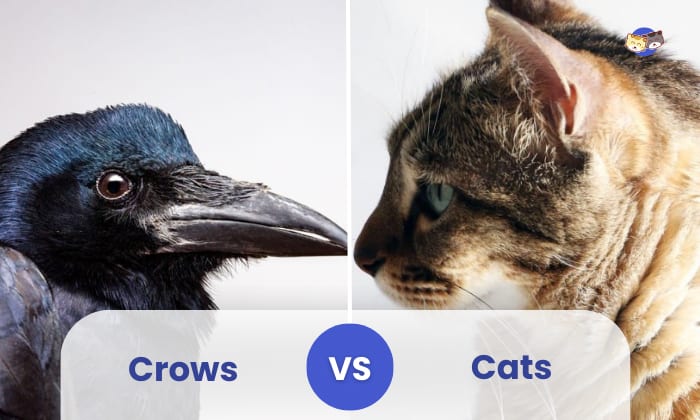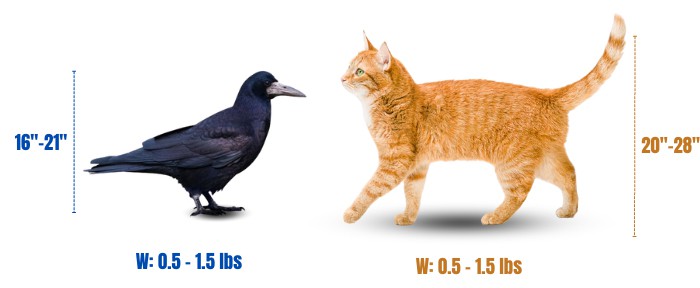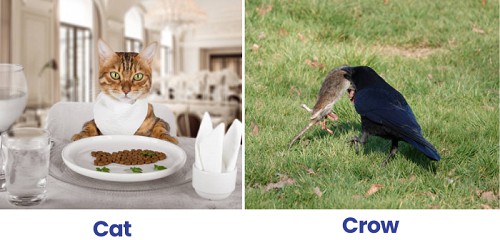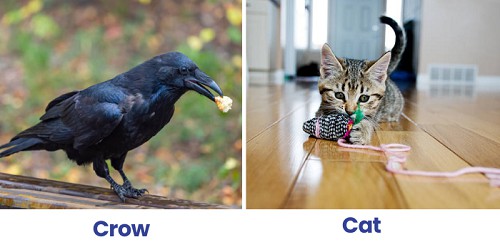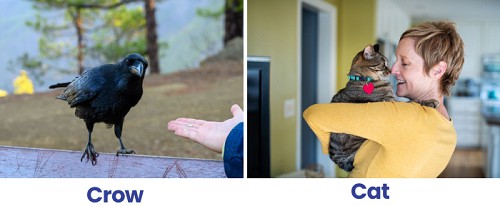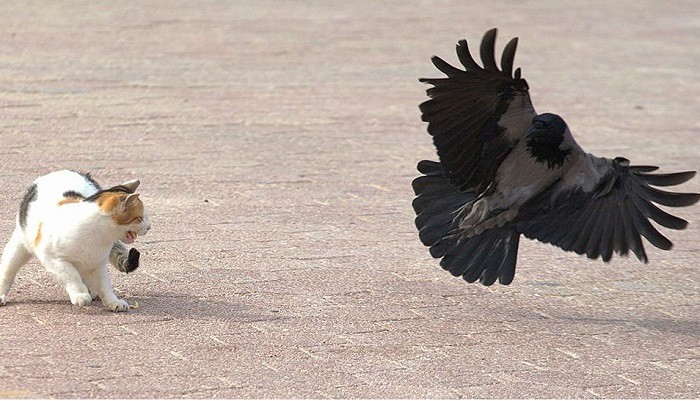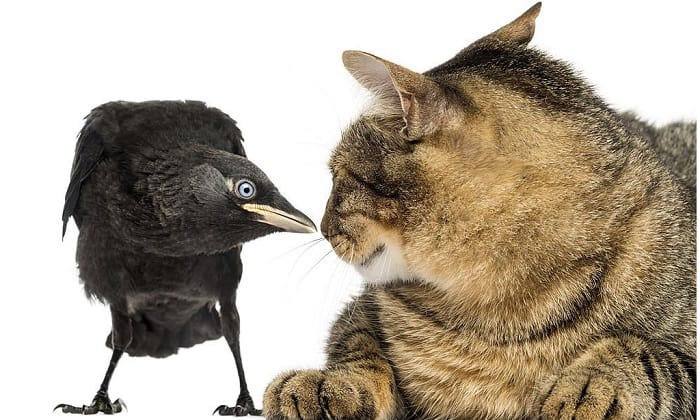The interactions between crows and cats are quite interesting. Crows often appear to start catfights, and they use distinct motivations and techniques to get the upper hand in the fight.
Read on as we decode the fascinating relationships between Crows vs Cats, from territorial disputes to humorous provocations. In addition, we look into instances where crows directly interact with cats, raising doubts regarding their role in feline interactions.
To give you an insight, here’s a comparison table.
| Aspect | Crows | Cats |
| Size | Length: 16-21 inches
Weight: 0.5 – 1.5 lbs |
Length: 20-28 inches
Weight: 8.5 – 11 lbs |
| Diet | Omnivorous | Wet food and dry food |
| Behavior | Flying low, sitting on fence or trees in the garden | Playful and loves socializing |
| Habitat | forests and suburban areas | Lives with human |
| Human Interaction | Can determine if a human is dangerous or not | loves human interaction |
Table of Contents
Comparison Between Crows and Cats
Discover the intriguing world of crows and cats by concisely exploring their size, diet, behavior, habitat, and interactions with humans.
These seemingly disparate creatures share our environment, and in this comparison, we uncover the fascinating distinctions and commonalities that define their lives.
1. Size
In terms of size, crows and cats show substantial differences. Crows often have beaks between 16 and 21 inches long and sleek, black plumage. They are pretty lightweight at 0.5 – 1.5 lbs, so they are definitely not equal to cats in terms of physical strength.
Cats range in size from 20 to 28 inches and are noted for their agility and predatory skills. A grown cat weighs around 8.5 – 11 lbs.
Due to their biological niches, crows thrive as opportunistic omnivores and agile flyers. In contrast, cats rely on their muscular bulk for covert hunting. This size contrast highlights this. Despite these distinctions, both species have adapted to various habitats, demonstrating the astounding diversity of the animal kingdom.
2. Diet
Crows and cats exhibit interesting differences in their diets. Crows are adaptable omnivores that enjoy a variety of foods, including insects, cereals, small animals, and leftover human food. They can survive in different circumstances thanks to their palate’s adaptability.
Cats, on the other hand, are strictly carnivorous and eat primarily animal products. They frequently eat wet food and dry food that has been particularly prepared to satisfy their dietary needs.
This dietary contrast highlights how creatures evolved to secure their survival in the natural world, with crows being unscrupulous scavengers and cats preserving their ancestral carnivorous character.
3. Behavior
Crows and cats each have distinct behavioral inclinations. Crows are very concerned about locating, obtaining, and eating food. They use various cunning foraging techniques, including employing tools or working with other crows to get supplies.
Cats, on the other hand, are renowned for their sociability and playful traits. They play with toys, explore their surroundings, interact with people and other animals, and pounce on objects. These divergent behaviors highlight the particular adaptations that each species has undergone.
Crows prioritize survival through resource acquisition, whereas cats prioritize social interaction and playfulness, which helps them adapt to a variety of social and environmental contexts.
4. Habitat
Crows and cats live in different types of habitats. Crows are adaptable animals that can be found in a variety of settings, including suburban areas and forests. They can prosper in both unaltered natural environments and those that have been altered by humans, thanks to their adaptability.
Cats, on the other hand, have a special and close relationship with people. Typically, they coexist with people in urban and rural settings, either as pets or as strays.
The dramatic discrepancy in habitat choices between these two species reflects the divergent evolutionary routes they have taken, with crows better suited to various habitats and cats becoming more and more ingrained in human culture.
5. Interaction With Human
Crows and cats display interesting contrasts in how they interact with people. Crows are remarkably adept at determining whether or not a human poses a threat. They exhibit sophisticated social intelligence since they can identify and recall specific individuals.
Cats, on the other hand, frequently seek out and love human contact. They develop relationships with their human companions to find love and company.
This highlights the differences between these species’ interactions with humans and their various roles in the human-animal relationship. Crows use their cognitive skills to identify danger. In contrast, cats emotionally interact with people to convey their social nature.
Overview of Cats vs Crows
Conflicts between crows and cats are an intriguing example of the interaction between bird intelligence and feline agility. Cats rely on their natural hunting instincts to ward off these avian enemies, whereas crows frequently use mobbing to scare or annoy them.
Here are some videos of them “fighting”:
Crows actually enjoy annoying animal, too:
Why Do Crows Make Cats Fight?
Occasionally, crow instigates cat fights to incite cat conflicts. This behavior may be motivated by instincts for territory, nest protection, or a calculated distraction to scavenge food while cats are preoccupied.
Understanding these causes helps us better understand the complex interactions of urban animals.
Do Crows Attack Cats?
In urban wildlife, it is a mystery whether crows purposefully attack cats.
Although crows typically avoid larger predators like cats, there have been cases where they have been seen engaged in conflict wherein cats attack crows.
Crows are frequently seen defending their nests or young during these interactions, sometimes from interested cats.
Because they are highly intelligent, crows may engage in mob behavior, in which several crows annoy cats. However, rather than harming the cat, these encounters frequently try to frighten it away.
Conclusion
Crows vs Cats coexisting in nature’s intricate dance provides an enthralling look at how animals interact and adapt to their surroundings. We have revealed a patchwork of contrasts and similarities using a perspective that includes size, nutrition, behavior, environment, and human interaction.
Occasionally, crows tease cats, although these interactions are the exception rather than the rule in their complex relationship.
Ultimately, these two species remind us of the astounding diversity in our common ecosystems thanks to their distinct characteristics and evolutionary histories.

I am Amy Sawy, a Doctor of Veterinary Medicine (DVM) graduate from the University of Kansas. y husband, Dr. Plummer, and I own a veterinary clinic in Phillipsburg, Kansas. In addition to my professional background, I am a devoted pet owner myself, with a household that includes dogs, rodents, and most notably, cats – a total of five felines in my home.
In 2020, I joined an organization as a professional writer, leveraging my experience and collaborating with my team to deliver the most valuable information for your cat’s care.


